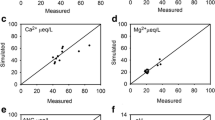Abstract
Woods Lake, in the Adirondack Mountains of New York, was the site of the Experimental Watershed Liming Study (EWLS) in which base addition was investigated as a method for mitigation of lake acidity. In an effort to predict the duration of effects, the treatment was simulated using the Integrated Lake-Watershed Acidification Study (ILWAS) model. To simulate terrestrial liming, calcite was applied to treated subcatchments as a rapidly weathering mineral in the upper horizon. Soil solution and lake outlet chemistry showed a response to calcite addition within four months of the start of the simulation. Calcium concentrations, acid neutralizing capacities (ANC), and pH increased in the upper soil layer and aluminum concentrations decreased in the upper three soil layers (0–70 cm). The response of ANC was delayed in lower soil layers due to proton production associated with aluminum hydrolysis. Moreover, soil water pH in the third soil layer decreased in response to calcite treatment due to the displacement of hydrogen ions by calcium added to the exchange complex. Calcium concentrations, ANC and pH increased and aluminum concentrations decreased in the simulated lake outlet.
The modeled effects of calcite treatment on the soil and lake outlet chemistry were not as great as field observations. This was, in part, attributed to the model representation of the watershed, which did not include streams, ponds, or wetlands located in the treated subcatchments. Calcite applied to these saturated areas in the field readily dissolved, supplying ANC to lake water. Additionally, incorporation of calcite into a thick organic layer in the model diminished the possibility of dissolution by contact with overland flow. Observed concentrations of calcium, ANC, and pH in the outlet decreased after high values in the two years after treatment. Although the model failed to match observed short-term data, it may simulate the long-term response as calcium is transported through the soil. A long-term simulation of the model suggests that effects of base treatment will persist for at least 50 years.
Similar content being viewed by others
References
Blette VL & Newton RM (1996) Effects of watershed liming on the soils of Woods Lake, New York. Biogeochemistry 32: 175–194 (this issue)
Bolan NS, Syers JK, Tillman RW & Scotter DR (1988) Effect of liming and phosphate additions on sulphate leaching in soils. Journal of Soil Science 38: 493–504
Brown DJA, Howells GD, Dalziel TRK & Stewart BR (1988) Loch Fleet — A research watershed liming project, Water, Air, and Soil Pollution 41: 25–41
Burns, DA (1993) Effects of CaCO3 application to an Adirondack lake watershed on outlet-stream chemistry. Biogeochemistry (in review)
Church MR, Thornton KW, Shaffer PW, Stevens DL, Rochelle BP, Holdren GR, Johnson MG, Lee JJ, Turner RS, Cassell DL, Lammers DA, Campbell WG, Liff CI, Brandt CC, Liegel LH, Bishop GD, Mortenson DC, Pierson SM & Schmoyer DD (1989) Direct/Delayed Response Project: Executive Summary — Future effects of long-term sulfur deposition on surface water chemistry in the Northeast and Southern Blue Ridge Province. EPA600/3-89/061a, U.S. EPA Office of Research and Development, Washington, DC and Environmental Research Laboratory, Corvallis, OR
Cirmo CP & Driscoll CT (1996) The impacts of a watershed CaCO3 treatment on stream and wetland biogeochemistry in the Adirondack Mountains. Biogeochemistry 32: 265–297 (this issue)
Davis GF, Whipple JJ, Gherini SA, Chen CW, Goldstein RA, Johannes AH, Chan PWH & Munson RK (1987) Big Moose Basin: simulation of response to acidic deposition. Biogeochemistry 3: 141–161
Davis JE (1988) The use of simulation models as resource management tools for restoring acidified waters. Water, Air, and Soil Pollution 41: 435–454
Davis JE & Goldstein RA (1988) Simulated response of an acidic Adirondack lake watershed to various liming mitigation strategies. Water Resources Research 24: 525–532
Driscoll CT, Cirmo CP, Fahey TJ, Blette VL, Burns DJ, Gubala CP, Newton RM, Raynal DJ, Schofield CL, Yavitt JB & Porcella DB (1996) The Experimental Watershed Liming Study (EWLS): Comparison of lake/watershed base neutralization strategies, Biogeochemistry 32: 143–174 (this issue)
Driscoll CT & Van Dreason R (1993) Seasonal and long-term temporal patterns in the chemistry of Adirondack lakes. Water, Air, and Soil Pollution 67: 319–345
Driscoll CT, Likens GE, Hedin LO, Eaton JS & Bormann FH (1989), Changes in the chemistry of surface waters. Environmental Science and Technology 23: 137–143
Geary R & Driscoll CT (1996) Forest soil solutions: acid/base chemistry and response to calcite treatment. Biogeochemistry 32: 195–220 (this issue)
Gherini SA, Mok L, Hudson RJM, Davis GF, Chen CW & Goldstein RA (1985) The ILWAS Model: Formulation and Application. Water, Air, and Soil Pollution 26: 425–459
Goldstein RA, Chen CW, & Gherini SA (1985) Integrated Lake-Watershed Acidification Study: Summary. Water, Air, and Soil Pollution 26: 327–337
Goldstein RA, Gherini SA, Chen CW, Mok L & Hudson RJM (1984) Integrated lake watershed acidification study (ILWAS): A mechanistic ecosystem analysis. Transactions of the Royal Society London B 305: 409–425
Schofield CL & Keleher C (1996) Comparison of brook trout reproductive success and recruitment in an acidic Adriondack lake following whole lake liming and watershed liming. Biogeochemistry 32: 323–338 (this issue)
Author information
Authors and Affiliations
Rights and permissions
About this article
Cite this article
Blette, V.L., Newton, R.M. Application of the integrated lake-watershed acidification study model to watershed liming at woods Lake, New York. Biogeochemistry 32, 363–383 (1996). https://doi.org/10.1007/BF02187146
Received:
Accepted:
Issue Date:
DOI: https://doi.org/10.1007/BF02187146




